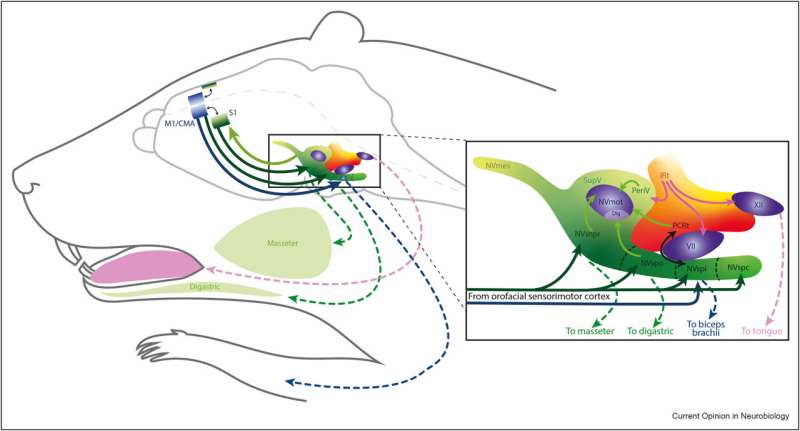This article has been reviewed according to Science X's editorial process and policies. Editors have highlighted the following attributes while ensuring the content's credibility:
fact-checked
trusted source
proofread
How the brain handles the complexity of chewing

You bite into an apple, you chew, the flavors flood your mouth, you swallow, and then you do it all over again. Eating is so effortless that you can do it while chatting, reading, watching TV, walking, working…
But it turns out your brain is working just as hard as your muscles to coordinate the many movements involved in eating, from the time you bite into that apple, to chewing and swallowing.
Chewing, walking and breathing are what neuroscientists call rhythmic movements. These are repetitive movements that can be consciously initiated, sped up, slowed down or even stopped, but otherwise are performed automatically and don't require our attention.
Arlette Kolta, a professor in Université de Montréal's departments of stomatology and neurosciences, studies how the brain controls the myriad movements involved in chewing.
Kolta and her Ph.D. student Dominic Falardeau recently published a literature review in Current Opinion in Neurobiology describing the complex mechanisms behind what they call the "masticatory machinery."
Complex neural pathways
Since all rhythmic movements are organized similarly in the brain, understanding how chewing works can shed light on rhythmic movements in general.
It is immediately clear from Kolta and Falardeau's review that chewing is indeed a very complex process. It starts with receptors in the mouth gathering sensory information about the piece of food. These include receptors located around the teeth and in the jaw muscles.
This sensory information is then transmitted to the brain, specifically to the sensory nuclei of the trigeminal nerve and premotor interneurons in the brainstem. These areas of the brain then use motor neurons to coordinate the muscles responsible for opening and closing the jaws to produce chewing.
While chewing may seem to be very repetitive and similar from one second to the next, its constituent movements are actually precisely adapted to the food's consistency and position in the mouth. This adaptation is achieved through continual sensory input, which is used to optimally position the food and regulate the force applied by the chewing muscles.
"The sensory information provides feedback that is used to modify chewing movements in real time," explained Falardeau. "So we don't chew all foods the same way."
When the food has been sufficiently chewed and mixed with saliva, it's time to swallow. This stage requires careful synchronization of muscles in the pharynx, larynx and esophagus, especially to prevent choking by aspirating food into the trachea. This is the job of the medulla oblongata.
Chewing is good for brain function
It also turns out that chewing significantly affects cognitive function in a variety of ways.
"The more we learn about the circuits responsible for coordinating chewing and other orofacial behaviors, the more we realize how complex they are," said Kolta.
She added that chewing, like all rhythmic movements, is associated with a host of cognitive benefits. For example, chewing movements enhance vigilance and attention by increasing levels of certain neurotransmitters involved in alertness. Chewing is also known to induce a theta rhythm in the hippocampus, a type of electrical activity that facilitates learning and memory.
Perhaps even more surprising is the finding that chewing increases blood flow, and therefore cell oxygenation, in brain areas important for cognition. This may explain why animal studies have shown that a liquid diet is associated with cognitive loss, even when that diet is nutritionally equivalent to a solid diet.
"Teachers have found that giving gum to children with attention deficit disorder can help them concentrate during tests," Kolta replied. "But that is only a neurological benefit. Yes, chewing gum can increase attention and alertness, but you also have to consider the wear and tear on the temporomandibular joints and teeth, the sugar and the risks associated with aspartame."
More information: Dominic Falardeau et al, The coordination of chewing, Current Opinion in Neurobiology (2023). DOI: 10.1016/j.conb.2023.102805





















